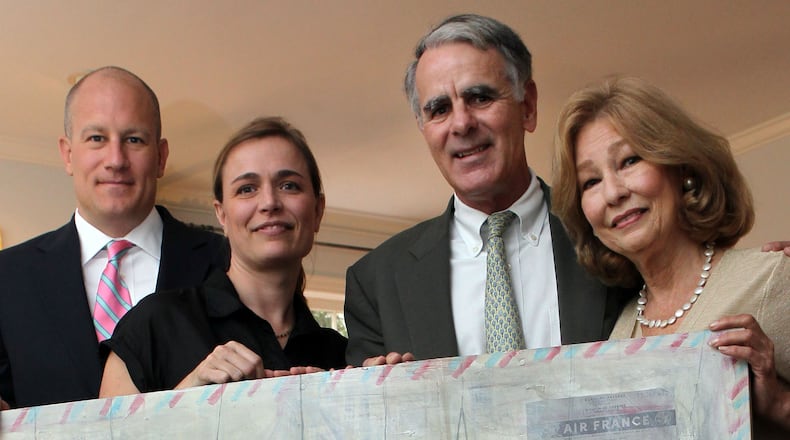The drawing is of ink, and iconic images of Atlanta jump out at once: A MARTA train powering across a track, the snarl of Spaghetti Junction, the skyline of Midtown, church windows that evoke the cluster of churches along Peachtree Road in Buckhead that some Atlantans call “Jesus Junction.”
Slowly, you begin to pick out other figures that seem unrelated, bits of Picasso’s “Guernica,” a vase of flowers, a black crow flying among tombstones marked “Mother,” “Father.” Off to one side is a headstone that reads “Orly.”
The name perhaps means nothing now to so many in this transient city. But that name represents a watershed moment in the city’s history, a disaster that crippled but ultimately pushed Atlanta’s burgeoning arts scene forward.
It was 50 years ago Wednesday when more than 100 of Atlanta’s most prominent arts supporters and patrons left for a three-week European tour that was part business, part pleasure. On June 3 of that year, as they began their return trip, their chartered jet crashed on takeoff at Orly Field outside Paris. One hundred and thirty died. Atlanta reeled. Entire families were lost, and a class of orphans instantly sprung up in the mansions of Buckhead, Ansley Park, Collier Hills and beyond.
This is the horror and legacy depicted in Atlanta artist Dennis Campay’s ink drawing “Passed Over.” It is one of 27 works inspired by the crash to be auctioned off Saturday at “Orly: Through the Eyes of Artists,” sponsored by the Buckhead Heritage Society. The auction, to be held at the Millennium Gate Georgia History Museum in Atlantic Station, is part of a two-day series commemorating the anniversary of the Orly crash. At the Cathedral of St. Philip in Buckhead on Friday, author Ann Uhry Abrams, who wrote “Explosion at Orly: The Disaster That Transformed Atlanta,” will speak about the tragedy. There will also be a showing of the 2001 Georgia Public Broadcasting documentary, “The Day Atlanta Stood Still,” and producer Chris Moser will introduce it.
That the Orly event has become lost history is what largely inspired artist and curator Katherine Bell McClure to put the show together. She grew up in Buckhead and knew well the history of the crash. Some of the descendants were her classmates and friends.
“I have always been fascinated by this event,” McClure said. “When you bring it up, it’s like talking about the [space shuttle] Challenger explosion. Everybody remembers where they were when they heard the news.”
But she was also aware that the word “Orly” meant nothing to plenty of others outside her circle. What’s now the Woodruff Arts Center, this city’s cultural powerhouse, came about in part as a result of the crash. Every day, scores of people walk right past the Rodin sculpture “The Shade,” outside the High, a sculpture given by the people of France in remembrance of the victims who formed the Atlanta Art Association. Few stop to read the plaque, which bears the names of those who perished.
Credit: Phil Skinner
Credit: Phil Skinner
“Arts and culture weren’t a part of this city’s soul, and they understood that was what the city needed in order to grow,” said Wright Mitchell, president of the Buckhead Heritage Society. “That’s what those folks were going to France to do because it was as much an ambassadorial mission as it was a pleasure trip.”
McClure’s piece depicts bits of the era and the fun the group was having during their trip. But deep in the background, there’s the shadow of the road that led from Orly to Paris, a road that inspired the name of McClure’s painting, “The Great Southern Road.” It’s all the more remarkable then that many of the pieces in Saturday’s show are in some ways uplifting. Artist Margaret Mangold’s piece, “Those Who Fly Yet,” is a mixed-media depiction of two young girls playing around the Rodin figure in the summer sun. In the photographs they look radiant. They are the actual great-granddaughters of a crash victim.
“I remember seeing the Rodin sculpture for the first time when I was little, and it is indelibly burned in my mind,” said Mangold, who was born years after the crash. “And in the years since, every time I go there are always children climbing all over him. I’ve noticed his fingers are burnished by so many children touching them.”
For Campay, who divides his time between Atlanta and Jacksonville, the connection was also direct. He is a graduate of the Atlanta College of Art, which was housed in the Woodruff arts complex.
“I went there in 1989 to 1992, and even established artists didn’t even talk about Orly,” Campay said. “I don’t think a lot of younger artists out there even know of it or its impact.”
A phoenix rises in his piece. It’s Atlanta’s symbol, representing its rise from the ashes of the Civil War. In “Passed Over,” it serves as a plea for remembrance of another moment that shaped the course of the city.
--------------------
Event preview
Orly lecture and film screening
Author Ann Uhry Abrams discusses her book “Explosion at Orly: The Disaster that Transformed Atlanta,” and Chris Moser, producer of the 2001 documentary “The Day Atlanta Stood Still,” introduces the film.
Friday, 6:30 p.m. $15. Child Hall at the Cathedral of St. Philip, 2744 Peachtree Road N.W. 404-467-9447, www.buckheadheritage.com.
“Orly: Through the Eyes of Artists”
Saturday, noon-5 p.m. Free. Millennium Gate at Atlantic Station, 395 17th St. N.W.
Art Auction and Cocktail Reception
Saturday, 7 to 10 p.m. $25. Millennium Gate at Atlantic Station, 395 17th St. N.W. 404-467-9447, www.buckheadheritage.com.
About the Author
Keep Reading
The Latest
Featured




